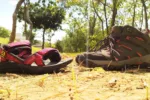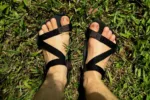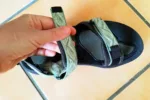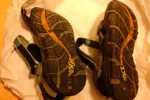How to choose the perfect hiking sandals
This post may contain affiliate links. This means that we may receive a small commission from purchases through those links. Read more in our affiliate disclosure.
So, you’ve decided to get yourself a pair of comfy hiking sandals, but don’t know which one to choose? Don’t worry, you’ve come to the right place!
A great hiking sandal is comfortable, durable, and provides good traction. Then, you have options: Do you want a thick sole for protection, or that barefoot feel? Arch support, or natural foot movement? A strong sandal that will be comfy all day, or a light one to slip on at camp? Do you need to accomodate wide feet or foot problems? There’s an option for everyone!
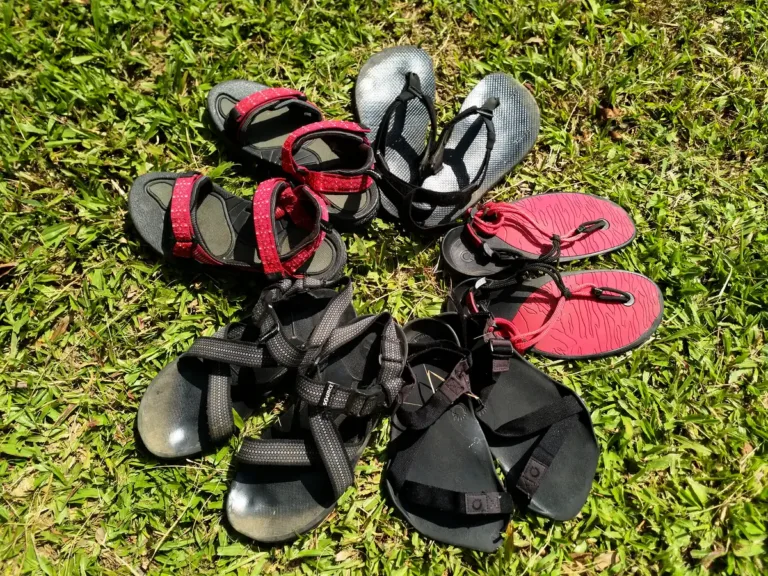
That’s quite the list of questions, especially if you’ve just found out about hiking sandals. But, but we’ll cover it all below! (And if they all sound good too you – perfectly understandable! I currently own nine pairs of different sandals that pretty much cover all of these categories…)
- Introduction
- Choosing the perfect hiking sandal: What to consider
- Level of protection
- Thick vs. thin sole
- Arch suppost vs. Zero drop
- Over-the-foot strap vs thong sandals
- Versatility
- Our best picks: Hiking Sandals for every preference
- Hiking sandals for Best Protection & arch support (Thick cushioned sole)
- Most comfortable & versatile Hiking sandals (with a thick cushioned sole)
- Best zero-drop Thong Hiking sandals (With a Medium-thick sole) – Best for wide feet
- Best Zero-drop hiking sandals (No Thong, super thin sole)
- Best Thin sole thong hiking sandals (Zero drop)
Choosing the perfect hiking sandal: What to consider
Let’s go through all of the parameters you might want to consider. It might seem like these are a lot of different issues, but in the end it boils down to a single question: Do you prefer a maximalist sandal with a lot of protection, a minimalist sandal which allows your feet to move freely, or something in between? Once you have an idea what you’d like, jump down below to see our best picks for every category.
Table of Contents
Level of protection
Sandals offer a widely warying level of protection for your toes & feet. Some models are basically just “shoes with air holes”, with a nice solid cap over your toes, so you won’t have to be afraid to bump into rocks. This offers most of the benefits of closed shoes, such as the option to have arch support, while providing your feet with a nice sweat-free environment. On the other hand, you lose out on some of the benefits that make sandals special, such as comfort and natural foot movement.
Thick vs. thin sole
The sole of a hiking sandal can be a few centimeters thick, or as thin as a couple of millimeters. This influences a few things:
- Obviously, the sole thickness decides how much of the ground you will feel. A thick-soled sandal cushions your foot from the ground, and you will barely notice the twigs and pebbles you step on, much like in a normal shoe. A thin sole lets you feel almost everything – while still protecting you from sharp edges. I personally like feeling the ground, it makes me feel connected to nature, and gives me a nice foot massage. But you do have to pay more attention to where you step.
- Very thin soles do simply not have the space for a deep profile, and as such provide less traction. This can be somewhat migitated if the bottom of the sole is made from good, non-slippery material; and depending on the weather conditions, you might not have to worry about traction. Can’t recommend slippery slopes on super-thin sandals, though.
- Sandals with really thin soles are super light and easy to pack – excellent as a backup on a long hike, where you might want to give your feet some variety.
- Thin soles are able to move with your foot much better. It’s all on a scale – on one hand we have thick hiking boots, that basically feel like hooves – your feet are well protected, but the boot barely changes shape as you walk. On the opposite end of the scale, you have thin hiking sandals, which not only allow your foot to naturally roll off the ground, but even adapt to your foot as it moves through the air. It’s really cool! And more importantly, it allows your foot to move naturally, much like our ancestor’s feet did. It’s a riveting subject! We’ll dive a bit deeper in the next section!
Arch suppost vs. Zero drop
There seems to be a deep divide in opinions between foot health experts.
On the one hand, you have the traditional approach of treating any issues like flat feet and over- or under-pronation with arch support and insoles and whatnot – the idea is to shove the foot into its “healty” position and not allow it to leave. These people would definitely recommend you wear boots, or maaaaybe almost-closed sandals with toe covers.
On the other hand, you have the proponents of the barefoot approach, who argue that modern footwear – narrow, fashionable footwear with thick, often heavily cushioned heels – is the root cause of all these common foot problems; and by allowing our feet to move naturally, and training them to be strong enough to do so, most modern foot problems can be avoided or even healed. And if you don’t want to go fully barefoot, this is where minimalist sandals come in: They provide enough protection from the grime and spikiness of the ground, while allowing your feet to function the way they evolved to move.
Now, I’m not an expert, I’m just a person with feet and opinions; so do your own research if you’re interested. But, I am strongly in the “barefoot style” camp. I used to have all kinds of issues – overpronation, flat feet, knee and hip pains just from hiking or running a little bit. But ever since I exiled those specialized inlays and expensive cushioned shoes and replaced them with zero-drop sandals and shoes – nothing. My joints are fine. I can run ultra-marathons. And I’ve recently been told my arches are too high now. Thanks, I’ll keep them as is! If you want to know more about barefoot runnning (but I think a lot of the lessons apply to hiking just as well!), I highly recommend the book Born to Run by Christopher McDougal (see here on Amazon), it’s a fascinating read. But we digress.
There are multiple aspects to footwear allowing natural movement:
- Zero-drop shoes have a sole that is the same thickness from front to back. Compare that to for example your typical running shoe, which has a really thick cushioned heel (and forces you to walk & run heel first). Zero-drop shoes allow a forefoot gait. Thin-soled
Over-the-foot strap vs thong sandals
Most sandals are held by straps going over your entire foot, which provides some protection, and is comfy for most people. And then, there are thong sandals, which have a support between your toes. Now, the idea of wearing thong sandals for hiking may seem uncomfortable – and yes, having a strap between your toes does take some time to get used to. Also, you might get scowled at for wearing “flip flops” on top of a mountain.
But, thong sandals are not flip flops. They are fastened securely to your foot, and due to the special way they are attached, they do a much better job at moving with your foot. Here’s what I mean:
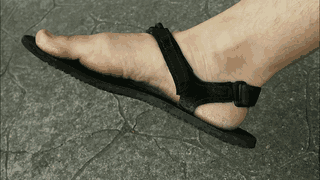
See how the sole stays perfectly aligned with my foot even as its shape changes? This gives you full control about how you make contact with the ground.
As an additional feat (pun retroactively fully intended), thong sandals do not constrain your foot. You got wide feet? No issue whatsoever! Your feet can be as wide as they want to!
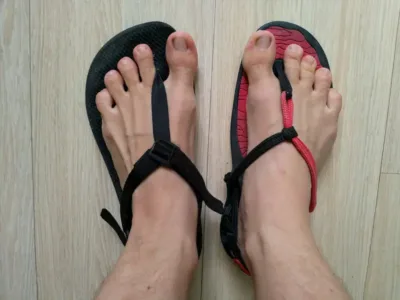
Another plus that’s pushed me towards adopting thong sandals is that they don’t trigger bunion pains, since you have nothing rubbing against that sensitive toe joint.
On the other hand, be careful with thong sandals if you expect to encounter a lot of mud. Mud not only makes the bottom of your sole slippery, but also the top – meaning you slip around inside your sandal more. In such situations, having plenty of over-the-foot straps keeps your sandal in place much better.
And if you find yourself pulling your foot out of a swamp, it’s nice to have the sandal stay on the foot instead of inside the swamp. Speaking from experience here.
Versatility
A hiking sandal doesn’t just have to be for hiking. There are many you can use in everyday life – in fact, for a long time I went absolutely everywhere in the same pair of Source Gobi sandals. Others can even be used for trail running!
Below, I’ll list our top picks for the best hiking sandals of each type. Once you’ve chosen one, also make sure you get the right size and fit!
Our best picks: Hiking Sandals for every preference
Hiking sandals for Best Protection & arch support (Thick cushioned sole)
A very popular closed-toe sandal is the Keen Newport H2 (see on Amazon: Women’s and Men’s). It provides good arch support, protects your feet all around – and I have friends who use them for trail running!
Most comfortable & versatile Hiking sandals (with a thick cushioned sole)
The most comfortable cushioned hiking sandal has got to be my long-time favourite, the Source Gobi hiking sandals (See: Women’s and Men’s). They are beautiful, and make your feet feel right at home. The Gobi’s profile provides traction wherever you go (I have traversed many rivers in these), and the straps and sole is cushioned enough that your feet are still protected from most dangers. My only issue is that they break after about one year of continued use. But then again, they’re the only pair on this list for which I can be sure how long they last, since I’ve walked at least seven pairs into oblivion. That’s how comfy they are.
Best zero-drop Thong Hiking sandals (With a Medium-thick sole) – Best for wide feet
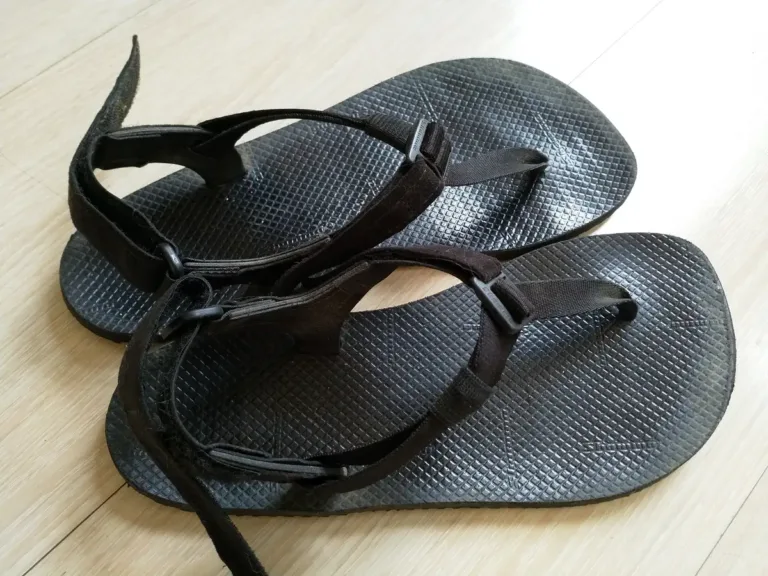
My newest favourite, the Shamma Warriors Maximus, are actually running sandals – but that doesn’t stop me from hiking in them! It takes a while to get used to the thong, and to the lack of cushioning – but then, they’re super comfortable. The sole is thick enough to not let sharp edges bother you, and has an excellent profile giving lots of traction, and they sit on your foot – I want to say like a glove, except better (as you saw in the gif above).
I’ve been wearing them for six months straight now, and they show no sign of breaking down.
I’d recommend starting slowly with these, if your feet aren’t used to barefoot-style shoes. But the freedom to just run off whenever you want is amazing!
Shamma also has other models with different sole thickness; I haven’t tried them, but looking into those might be worthwhile!
Best Zero-drop hiking sandals (No Thong, super thin sole)
Now we’re getting into the ultralight options with millimeter-thin soles. If you don’t want a thong, the Xero Z-trail would be an excellent choice. They hold onto the foot well, give good traction in dry weather, and are super easily rolled up and stuffed into your backpack.
Best Thin sole thong hiking sandals (Zero drop)
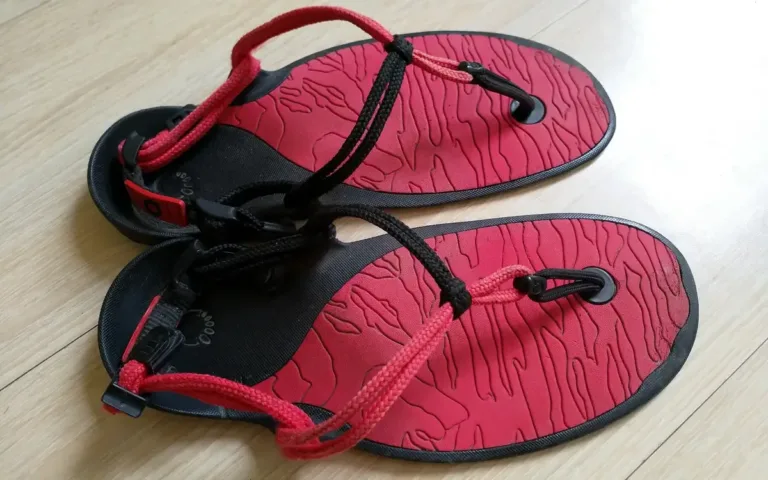
The Xero Amuri Cloud are an excellent ultralight thong option. They’re quick to slip on and give a great barefoot feel. On the other hand, I’d recommend using these as backups on long hikes, as there are a few spots that can start rubbing after an hour or so.

